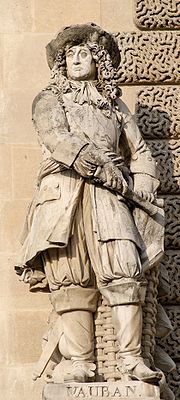
Gustave Crauck
Encyclopedia

France
The French Republic , The French Republic , The French Republic , (commonly known as France , is a unitary semi-presidential republic in Western Europe with several overseas territories and islands located on other continents and in the Indian, Pacific, and Atlantic oceans. Metropolitan France...
sculptor
Sculpture
Sculpture is three-dimensional artwork created by shaping or combining hard materials—typically stone such as marble—or metal, glass, or wood. Softer materials can also be used, such as clay, textiles, plastics, polymers and softer metals...
with a long distinguished career.
He was born and died at Valenciennes
Valenciennes
Valenciennes is a commune in the Nord department in northern France.It lies on the Scheldt river. Although the city and region had seen a steady decline between 1975 and 1990, it has since rebounded...
, where a special museum for his works was erected in his honor. Educated at the Ecole des Beaux-Arts
École des Beaux-Arts
École des Beaux-Arts refers to a number of influential art schools in France. The most famous is the École nationale supérieure des Beaux-Arts, now located on the left bank in Paris, across the Seine from the Louvre, in the 6th arrondissement. The school has a history spanning more than 350 years,...
, Crauk took the Prix de Rome
Prix de Rome
The Prix de Rome was a scholarship for arts students, principally of painting, sculpture, and architecture. It was created, initially for painters and sculptors, in 1663 in France during the reign of Louis XIV. It was an annual bursary for promising artists having proved their talents by...
in 1851.
Little known to the world at large during his long life, he ranks among the best modern sculptors of France. At Paris
Paris
Paris is the capital and largest city in France, situated on the river Seine, in northern France, at the heart of the Île-de-France region...
his Coligny
Gaspard de Coligny
Gaspard de Coligny , Seigneur de Châtillon, was a French nobleman and admiral, best remembered as a disciplined Huguenot leader in the French Wars of Religion.-Ancestry:...
monument is in the rue de Rivoli; his Victory in the Place des Arts et Métiers; and Twilight in the Avenue de l'Observatoire. Among his finest works is his Combat du Centaure, on which he was engaged for thirty years, the figure of the Lapith
Lapith
The Lapiths are a legendary people of Greek mythology, whose home was in Thessaly, in the valley of the Peneus and on the mountain Pelion.They were an Aeolian tribe. Like the Myrmidons and other Thessalian tribes, the Lapiths were pre-Hellenic in their origins...
having been modelled after the strongman, Eugene Sandow.
He also sculpted the monuments of Jules-Auguste Béclard
Jules-Auguste Béclard
Jules-Auguste Béclard was a French physiologist born in Paris. He was the son of anatomist Pierre Augustin Béclard ....
and Edmond About among several of his works at Pere Lachaise Cemetery in Paris. He contributed the figures of Douai
Douai
-Main sights:Douai's ornate Gothic style belfry was begun in 1380, on the site of an earlier tower. The 80 m high structure includes an impressive carillon, consisting of 62 bells spanning 5 octaves. The originals, some dating from 1391 were removed in 1917 during World War I by the occupying...
and Dunkirk to the facade of the Gare du Nord
Gare du Nord
Paris Nord is one of the six large terminus railway stations of the SNCF mainline network for Paris, France. It offers connections with several urban transportation lines, including Paris Métro and RER...
, and contributed the figure of Vauban
Vauban
Sébastien Le Prestre, Seigneur de Vauban and later Marquis de Vauban , commonly referred to as Vauban, was a Marshal of France and the foremost military engineer of his age, famed for his skill in both designing fortifications and breaking through them...
for the facade of the Palais du Louvre
Palais du Louvre
The Louvre Palace , on the Right Bank of the Seine in Paris, is a former royal palace situated between the Tuileries Gardens and the church of Saint-Germain l'Auxerrois...
.
In 1907 an exhibition of his works was held in the Ecole des Beaux-Arts
École des Beaux-Arts
École des Beaux-Arts refers to a number of influential art schools in France. The most famous is the École nationale supérieure des Beaux-Arts, now located on the left bank in Paris, across the Seine from the Louvre, in the 6th arrondissement. The school has a history spanning more than 350 years,...
.

